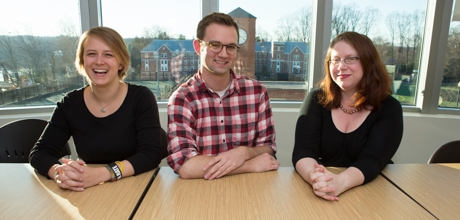It’s easy to get ignored online, and the folks who work to engage and advise students at George Washington’s University Honors Program know that.
That’s why a blog post promoting a student-faculty dinner turns into a gif of Liz Lemon saying, “I want to go to there.” And it’s also why they tapped into the popularity of the feminist Ryan Gosling meme when telling students to make an appointment for advising: “Hey girl. Walk-ins don’t last forever; they’re special. Just like you.”
“Students read the information, laugh about it, and—here’s the key—they’ll remember it,” said Jared Meyer, the Honors Program communications coordinator.
With emails (used sparingly); Facebook, Twitter and Google+ posts; and a blog, Mr. Meyer and program officers Catherine Chandler and Liz Sutton command an effective communications strategy that engages, informs and equips students to take action.
The Liz Lemon and Ryan Gosling posts use humor to nab students’ attention, but depending on the information, interesting stories, videos—even just some great writing—might be equally effective, Mr. Meyer said.
“You need them to know that when you email them, they’ll mostly enjoy what you have to say,” Mr. Meyer said. “They’ll open the email hoping for a great joke or cool article, and they’ll spot that there’s a form deadline coming up soon.”
But gone are the days when email was the only way to communicate. It’s not that it’s a bad vehicle; it’s just that it’s abused—like in cases of sending huge blocks of text multiple times a week to the dreaded listserv, Mr. Meyer said. He also cautions against sending another email on a certain subject if students weren’t receptive to the first. If you’ve provided the information but students don’t know it, Mr. Meyer said, you’ve got an engagement problem—not an information problem.
“For a lot of offices, email is the only communications tool they’ve got in their toolbox,” he said. “If you’ve only got a hammer, everything looks like a nail. Students are tired of getting email-bludgeoned, so they’re deleting messages right away. It’s hard to blame them.”
Emails do have a place, Mr. Meyer said. Just make them goofy, brief, with lots of visuals. Use a picture of a mad scientist to advertise a research assistantship, or a dinosaur that makes a Jurassic Park joke to advertise an undergraduate research enhancement award.
Not all information is suited for every medium, though.
For example, timely information on an upcoming event shouldn’t go on something like a program’s homepage, which is better for official, static information.
Twitter and Facebook are good for events and funny messages—and making more personal connections with students. Mr. Meyer said the program frequently takes pictures and uploads them to Facebook so students can tag themselves and each other. And something as simple as asking students to “like” a post if they’re glad finals are over, and comment about what class they’re excited for next semester, is a quick, easy way to engage and spark conversations with them. “It doesn’t have to be complicated,” he said.
The bottom line, Mr. Meyer said, is to remember two things.
“I love my job because I get to apply two simple rules to everything I do—one, make it fun, and two, make it easy,” he said. “But I don’t follow those two rules because it makes my job enjoyable—I follow them because it’s effective.”
Ultimately, social media is where students want to engage, Ms. Chandler said.
“We have to meet students where they are rather than drag them along where we’ve been,” she said. “If we want them to learn to help themselves, learn autonomy and resilience, we need to put the tools they need where they’ll find them.”
The Honors Program’s work hasn’t gone unrecognized. Mr. Meyer and his colleagues were voted best in the region after presenting on their efforts at a recent National Academic Advisors Association regional conference. That sent them to the national conference to speak in front of a full house of 250 audience members.
“We were thrilled with how much other advisers enjoyed our session,” Ms. Chandler said. “Besides the various ways to save time and frustration, many people found the social media strategies liberating, that they could reach out to students in new ways that are both personal and professional.”


